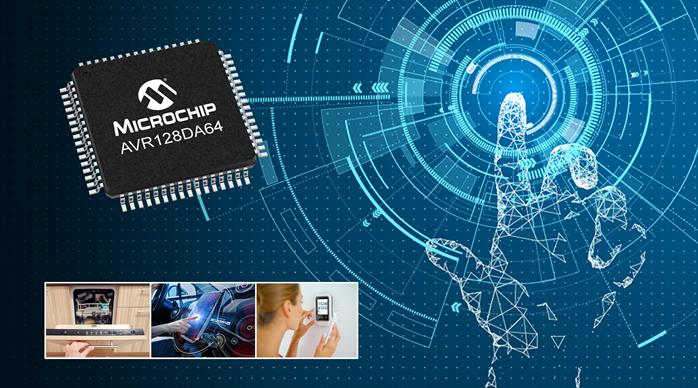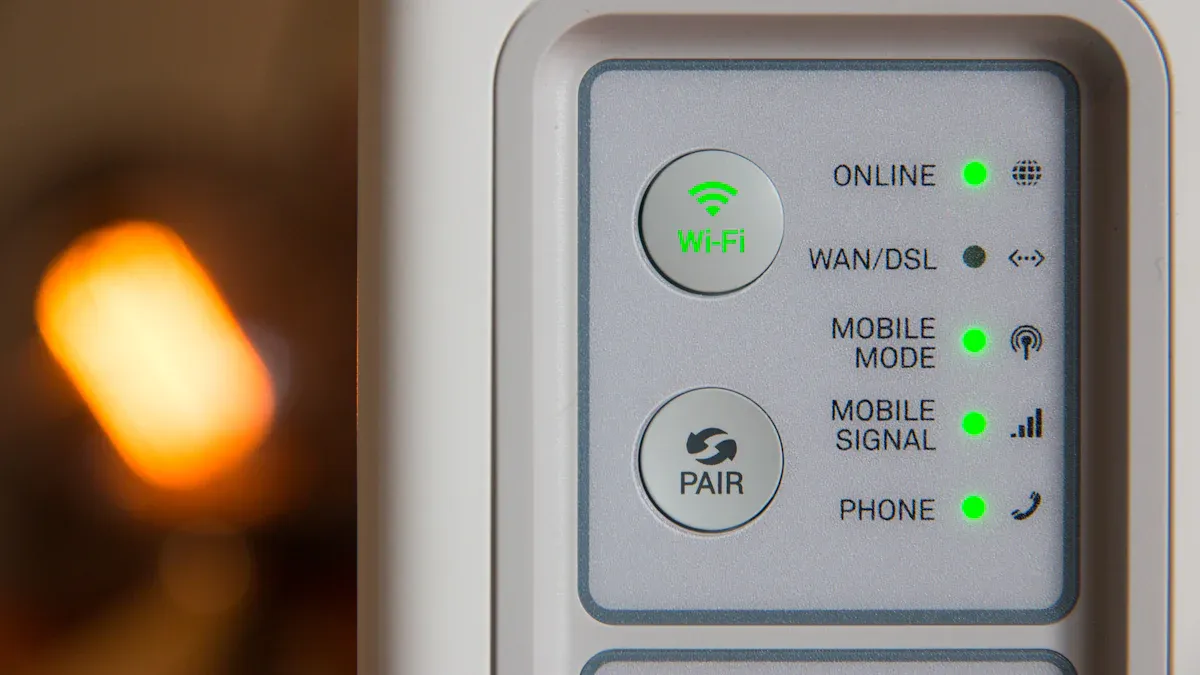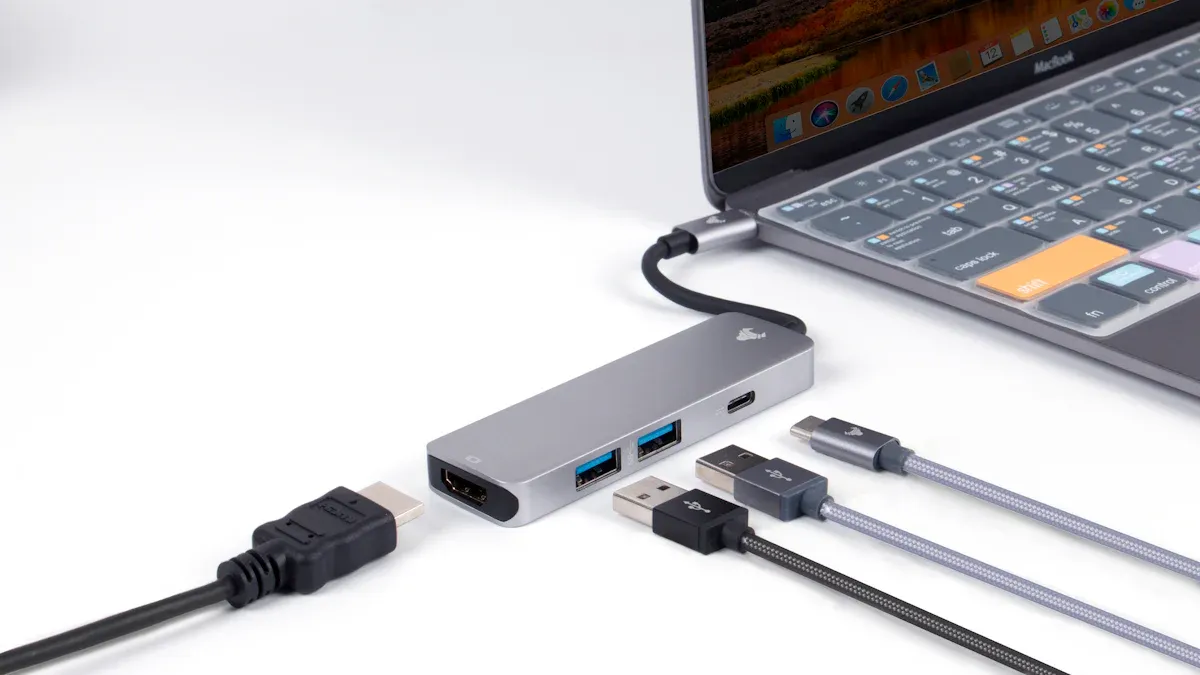How AVR EB MCUs Empower Next-Generation Stepper Motor Systems

Stepper motors have become essential components in modern devices, powering everything from industrial machinery to consumer gadgets. To meet the growing demand for smarter stepper motors, AVR EB microcontrollers provide a transformative solution. These advanced controllers improve motor performance by enabling precise signal generation and real-time adjustments. Their ability to enhance efficiency and control ensures seamless operation across diverse applications. With innovative features, AVR EB MCUs address common challenges, making stepper motors more reliable and adaptable to today’s technological needs.
Key Takeaways
AVR EB microcontrollers improve stepper motors by giving better control. They make movements smooth and adjust quickly for different uses.
These microcontrollers save energy, helping devices last longer. They also create less heat, which is great for gadgets using batteries.
AVR EB microcontrollers are flexible and easy to adjust. This makes them useful for many things, like robots and home devices.
Special features like Timer/Counter Type-E help make signals accurate. They fix problems found in older stepper motor systems.
These microcontrollers work well with Arduino tools. This makes building new ideas for automation and IoT faster and easier.
Understanding AVR Microcontrollers

What Are AVR EB Microcontrollers?
AVR EB microcontrollers belong to the AVR family, a series of 8-bit RISC single-chip microcontrollers designed for high performance and efficiency. These microcontrollers utilize a modified Harvard architecture, enabling simultaneous access to instructions and data. AVR EB microcontrollers are specifically tailored for applications requiring precise control, such as stepper motor systems and other embedded systems.
The AVR EB series stands out due to its advanced peripherals, including Timer/Counter Type-E (TCE) and Waveform Extension (WEX), which enhance motor control capabilities. These microcontrollers integrate on-chip flash memory, EEPROM, and SRAM, making them compact and versatile. Their ability to execute instructions efficiently ensures optimal performance in real-time applications.
Developers often choose AVR EB microcontrollers for their compatibility with AVR development tools and their ease of use in embedded applications. These microcontrollers also support AVR programming, allowing for seamless integration into various projects, including Arduino-based systems.
Key Features of AVR EB Microcontrollers
AVR EB microcontrollers offer a range of features that make them ideal for modern applications. The following table highlights some of their technical specifications:
Specification | Details |
|---|---|
Architecture | 8-bit RISC single-chip microcontrollers based on modified Harvard architecture |
Memory Types | On-chip flash memory, EEPROM, and SRAM integrated onto a single chip |
Clock Speeds | Typically supports 0 to 20 MHz, with some devices reaching 32 MHz |
Features | Multifunction I/O ports, internal oscillators, self-programmable flash memory up to 256 KB |
On-chip Debugging | Support through JTAG or debugWIRE on most devices |
These features enable AVR EB microcontrollers to deliver high performance and flexibility. The AVR architecture ensures efficient instruction execution, achieving throughputs of up to 1 MIPS per MHz. This balance between processing speed and power consumption makes them suitable for energy-efficient designs.
Applications of AVR EB microcontrollers include washing machines, microwaves, motor cars, and smart card systems. Their integration into Arduino projects further demonstrates their versatility. Developers benefit from their robust flash memory and compatibility with AVR development tools, which simplify the design process.
Tip: The AVR instruction set and programming flexibility make these microcontrollers a popular choice for embedded systems requiring precise control and reliability.
Challenges in Smarter Stepper Motors

Common Issues in Traditional Stepper Motor Systems
Traditional stepper motor systems often face performance limitations that hinder their efficiency and reliability. One significant issue is the resonance effect, which occurs at low speeds and can cause vibrations, reducing precision. Additionally, as speed increases, torque tends to decrease, limiting the motor's ability to handle heavier loads effectively. These challenges make traditional systems less suitable for applications requiring high accuracy and smooth operation.
Motor fatigue is another common problem. Continuous duty operation and high-duty cycles can lead to wear and tear, shortening the motor's lifespan. For example, running a motor at double its rated voltage may increase output but can also accelerate fatigue. Environmental factors, such as humidity and heat, further exacerbate these issues. Mechanical problems, including side loading, can also impact performance and durability.
Other challenges include:
Stalling, which can generate voltage spikes that damage the driver.
Back-driving, which creates back EMF voltage, potentially harming the driver if not managed properly.
These issues highlight the need for smarter solutions to enhance stepper motor performance and longevity.
The Need for Advanced Microcontrollers in Modern Systems
Modern stepper motor systems demand advanced microcontrollers to address these challenges and meet the requirements of emerging applications. The growing adoption of IoT devices and connected systems has driven the need for precise, efficient, and reliable motor control. Advanced microcontrollers, such as the AVR series, play a crucial role in achieving these goals.
Industry research underscores the importance of advanced microcontrollers in various applications:
Application Area | Importance of Stepper Motors |
|---|---|
Essential for precise motion control. | |
CNC Machines | Provides high accuracy and repeatability in motion. |
Robotics | Critical for automation and precise mechanical control. |
Medical Devices | Used for accurate positioning and control in medical applications. |
Automated Manufacturing | Enhances productivity and efficiency in manufacturing processes. |
The AVR microcontroller family, particularly the AVR EB series, offers the features needed to meet these demands. These microcontrollers provide precise control, energy efficiency, and scalability, making them ideal for cost-sensitive and high-performance applications alike. Their ability to handle real-time adjustments ensures optimal performance across diverse use cases, from consumer electronics to industrial automation.
How AVR EB Microcontrollers Solve These Challenges

Enhanced Motor Control and Precision
AVR EB microcontrollers excel in delivering precise motor control, a critical requirement for smarter stepper motors. The Timer/Counter Type-E (TCE) and Waveform Extension (WEX) peripherals allow these microcontrollers to generate accurate control signals. This capability ensures smooth operation, even in applications requiring micro-stepping up to 1/32.
The AVR instruction set plays a vital role in achieving this precision. It enables efficient execution of control algorithms, ensuring real-time adjustments to motor behavior. For example, in a microcontroller-based stepper motor system, the AVR architecture allows the motor to respond instantly to feedback from sensors. This responsiveness minimizes issues like stalling and resonance, which are common in traditional systems.
Additionally, the integration of analog comparators and configurable custom logic enhances safety. These features enable the microcontroller to monitor current levels and shut down the motor if thresholds are exceeded. This level of control makes AVR microcontrollers ideal for applications like robotics, CNC machines, and medical devices, where accuracy and reliability are paramount.
Note: The ability to execute precise control algorithms makes AVR EB microcontrollers a cornerstone for embedded systems requiring high precision.
Energy Efficiency and Power Optimization
Energy efficiency is a key advantage of AVR EB microcontrollers. These microcontrollers are designed to optimize power consumption without compromising performance. The AVR instruction set ensures that each operation is executed with minimal energy use, achieving up to 1 MIPS per MHz.
In stepper motor systems, energy efficiency translates to longer operational lifespans and reduced heat generation. AVR EB microcontrollers support power inputs ranging from 12V to 30V, making them versatile for various applications. The ability to control motor current through both hardware and software further enhances efficiency. For instance, the microcontroller can adjust the current waveform to match the motor's requirements, reducing unnecessary power usage.
The inclusion of on-chip flash memory also contributes to energy savings. By storing control algorithms and data locally, the microcontroller minimizes the need for external memory access, which can be energy-intensive. This feature is particularly beneficial in IoT devices and consumer electronics, where battery life is a critical factor.
Tip: Developers can leverage the energy-efficient design of AVR EB microcontrollers to create sustainable and cost-effective solutions.
Flexibility and Scalability for Diverse Applications
AVR EB microcontrollers offer unparalleled flexibility, making them suitable for a wide range of applications. Their multifunction I/O ports and pre-allocated functionalities for analog signals, SPI, I2C, and UART provide developers with the tools needed to customize designs. These features make it easy to adapt the microcontroller for specific use cases, from industrial automation to Arduino-based projects.
Scalability is another strength of AVR EB microcontrollers. The ability to reassign I/O functions through software allows developers to expand or modify their systems without significant hardware changes. For example, a single microcontroller can be used to control multiple stepper motors in a manufacturing setup, reducing costs and complexity.
The robust flash memory and compatibility with AVR development tools further enhance scalability. Developers can easily update firmware or add new features, ensuring that their systems remain future-proof. This adaptability makes AVR microcontrollers a preferred choice for embedded applications requiring long-term reliability.
Callout: The combination of flexibility and scalability ensures that AVR EB microcontrollers can meet the evolving demands of modern technology.
Real-World Applications of AVR Microcontrollers

Industrial Automation and Robotics
AVR microcontrollers play a pivotal role in industrial automation and robotics by enabling precise control and efficient operation. Their advanced features, such as the AVR instruction set and on-chip flash memory, make them ideal for managing complex tasks in real-time. These microcontrollers excel in applications requiring high accuracy, such as robotic arms, conveyor systems, and automated assembly lines. Their ability to execute instructions efficiently ensures smooth and reliable performance, even in demanding environments.
The Robo-Platform project demonstrates the versatility of AVR microcontrollers in robotics. This system integrates various Arduino boards and a custom AVR board to control sensors and robotic movements. The detailed schematics and code highlight how these microcontrollers streamline automation processes. Another example is an automated aquaponics system that uses an AVR microcontroller to monitor and adjust environmental conditions. This application showcases the microcontroller's effectiveness in optimizing plant growth through precise control.
In industrial settings, AVR microcontrollers enhance productivity by automating repetitive tasks. For instance, they can control stepper motors in CNC machines, ensuring accurate and consistent motion. Their compatibility with the Arduino platform simplifies development, allowing engineers to prototype and implement solutions quickly. The robust design of these microcontrollers ensures durability, making them suitable for long-term use in harsh industrial environments.
Note: The integration of AVR microcontrollers in robotics and automation highlights their adaptability and reliability in diverse applications.
Consumer Electronics and IoT Devices
AVR microcontrollers have become indispensable in consumer electronics and IoT devices due to their efficiency and low power consumption. These microcontrollers power a wide range of devices, including smart home systems, wearables, and healthcare equipment. Their compact design and energy-efficient operation make them ideal for battery-powered applications, where longevity is crucial.
The market for AVR microcontrollers is experiencing significant growth, driven by the increasing demand for IoT devices and automation. Projections indicate that the market will grow from USD 4.5 billion in 2023 to USD 7.8 billion by 2032, with a compound annual growth rate (CAGR) of 5.8%. This growth reflects the rising adoption of smart technologies across various sectors. AVR microcontrollers are essential in meeting this demand, offering features like flash memory and multifunction I/O ports that simplify embedded systems development.
In smart home devices, AVR microcontrollers enable seamless integration and control. For example, they can manage lighting systems, thermostats, and security cameras, ensuring efficient operation. In wearables, these microcontrollers provide accurate data processing for fitness tracking and health monitoring. Their ability to handle real-time adjustments enhances the user experience, making them a preferred choice for developers.
The advancements in semiconductor technology have further improved the performance of AVR microcontrollers. These improvements allow for greater functionality in smaller devices, supporting the development of innovative IoT solutions. The flexibility of AVR architecture enables developers to customize designs, ensuring compatibility with various applications. This adaptability makes AVR microcontrollers a cornerstone of modern consumer electronics.
Tip: Developers can leverage the energy-efficient design and advanced features of AVR microcontrollers to create cutting-edge IoT devices.
AVR EB microcontrollers revolutionize smarter stepper motors by addressing traditional challenges like precision and energy efficiency. Their advanced features, including flash memory and real-time control, enable seamless operation across diverse applications. These microcontrollers simplify development by offering flexibility and scalability, making them ideal for modern systems. Their role in enhancing motor performance highlights their potential to drive future innovations in robotics, IoT, and industrial automation. As technology evolves, AVR microcontrollers will continue to empower smarter stepper motors, shaping the next generation of intelligent systems.

What makes AVR EB microcontrollers ideal for stepper motor systems?
AVR EB microcontrollers feature advanced peripherals like Timer/Counter Type-E (TCE) and Waveform Extension (WEX). These enable precise signal generation and real-time adjustments, ensuring smooth operation. Their energy-efficient design and scalability make them suitable for diverse applications, including robotics and industrial automation.
How do AVR EB microcontrollers improve energy efficiency?
AVR EB microcontrollers optimize power consumption through efficient instruction execution and hardware-software integration. They adjust motor current waveforms to match operational needs, reducing unnecessary energy use. This design supports sustainable solutions, especially in battery-powered devices like IoT systems and consumer electronics.
Can AVR EB microcontrollers handle multiple stepper motors?
Yes, AVR EB microcontrollers offer flexible I/O ports and software-reassignable functions. Developers can control multiple stepper motors using a single microcontroller, simplifying system design and reducing costs. This scalability makes them ideal for manufacturing setups and complex automation projects.
Are AVR EB microcontrollers compatible with Arduino?
AVR EB microcontrollers integrate seamlessly with Arduino development tools. Their compatibility simplifies prototyping and accelerates project development. Developers can leverage Arduino libraries and frameworks to create innovative solutions for robotics, IoT devices, and consumer electronics.
What safety features do AVR EB microcontrollers provide?
AVR EB microcontrollers include analog comparators and configurable custom logic for real-time monitoring. These features ensure safe operation by shutting down the motor when current levels exceed programmed thresholds. This makes them reliable for applications requiring high precision and safety, such as medical devices and CNC machines.
See Also
Integrating AEAT-8800-Q24 For Improved Robotics Efficiency
Three Methods ATIC83E2 Revolutionizes Industrial Automation
RV1126 Fuels AI Edge Computing For Robotics Applications
SPC56 Microcontrollers Provide Simple Solutions For Engine Control
CALL US DIRECTLY
(+86)755-82724686
RM2508,BlockA,JiaheHuaqiangBuilding,ShenNanMiddleRd,Futian District,Shenzhen,518031,CN
www.keepboomingtech.com sales@keepboomingtech.com
